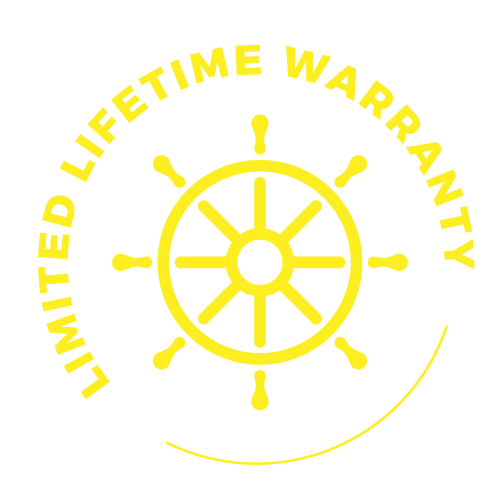The thrill of sailing comes with the responsibility of keeping our vessels safe and secure during stormy weather. Challenging weather conditions can pose serious risks to both the boat and those on board. Therefore, it is important to be thoroughly prepared to handle any unexpected obstacles that may arise. In this guide, we’ll take you through 7 essential measures to protect your boat during storms and inclement weather.
Firstly, stay informed! If you’re planning to take your boat for a sail, closely monitor local weather forecasts and advisories. Download weather apps, and visit websites that provide real-time updates on potential hazards. Knowing when a storm is approaching will give you plenty of time to take necessary precautions and plan accordingly.
In addition, weather forecasts such as Buoyweather provide detailed information on wind speed, wave height, precipitation, and storm track predictions. By paying attention to warnings or watches issued by meteorological agencies, you can assess severe weather conditions before they arrive. Make informed decisions regarding your boating plans with the help of weather forecasts.
When a storm does come unexpectedly, a well-organized checklist can save you time and stress. Create a comprehensive storm preparation checklist to help you remember all essential tasks. From securing loose gear to ensuring that emergency equipment is stocked, this list should include every item you need to prepare for a storm.
One place to start is your boat’s manual. Once you are familiar with your specific vessel, you can create a tailored checklist that meets your boat’s unique requirements. Additionally, consider seeking guidance from seasoned boaters to compile a comprehensive checklist. Don’t forget to organize the tasks chronologically or by priority! This ensures that you have a clear, step-by-step guide at your disposal whenever you need it.
Before a storm hits, make sure all loose gear and equipment are properly stowed and secured. Avoid damage or injury from shifting or flying items. Anything left unsecured can be picked up by heavy seas and strong winds, so it is important to thoroughly secure any equipment that could become a hazard.
Personal items and loose gear are best stored in lockers, below deck, or indoors. Also consider using bins, storage containers, or nets to keep items in place. For larger equipment that is harder to store, use straps, bungee cords, or lines to tie them down securely.
A well-functioning bilge pump is crucial in effectively removing water that accumulates in boats during heavy rain or rough seas. Regularly inspect and test your bilge pump to ensure it is in good working condition. Clogged or damaged pump filters or hoses make it difficult for your boat to channel out excess water.
In addition to bilge pumps, inspect and clear all drains on the boat. Drains play a vital role in draining water from the deck and other areas. Ensure that they are free from debris and properly functioning to prevent water from pooling, which could lead to instability or flooding.
If your boat uses mooring lines or an anchor, understand that their strength and security are vital during storms. Mooring lines are the primary means of securing your boat to the dock or mooring buoy. Check all lines for signs of wear, and replace any that appear frayed or damaged. Also consider using chafe protection to shield lines from rubbing against sharp edges, which can gradually weaken them.
If you plan to anchor during the storm, ensure that you have a reliable and sufficient length of anchor rod. Anchoring in a sheltered location with good holding ground and using two anchors can improve stability, especially if you expect the wind and current to shift.
During stormy weather, access to essential emergency equipment can be a lifesaver. Make sure your boat is equipped with life jackets, first aid kits, flares, a VHF radio, and a fully charged flashlight. Familiarize yourself with the locations and usage of all emergency equipment.
Life jackets should be readily available and sized correctly for each person. A well-equipped first aid kit should include bandages, antiseptics, pain relievers, and other necessary medical supplies. In addition, make sure that your VHF radio is in good working order and is able to contact emergency services. Lastly, keep a fully charged flashlight within reach in case of power outages or low visibility.
In addition to the essential preparations for stormy weather, boat owners should also consider investing in a boat lift canopy cover to provide an extra layer of protection for their vessels. Boat lift canopy covers are specially designed covers that shield boats from the elements when they are not in use. These covers offer several advantages, especially during inclement weather.
Firstly, they protect the boat’s exterior from rain and harmful UV rays, preventing damage such as fading, cracking, and water intrusion. Secondly, the canopy cover acts as a barrier against leaves, debris, and bird droppings, keeping the boat’s deck clean and reducing the maintenance required after a storm. A well-secured canopy cover can also prevent water from accumulating on the boat, reducing the risk of excess weight and potential damage to the boat’s structure.
When choosing a boat lift canopy cover, opt for high-quality, durable materials that can withstand harsh weather conditions and ensure a proper fit to maximize its protective benefits. By including boat lift canopy covers in their storm preparation plans, boat owners can add an extra layer of defense to keep their prized vessels safe. If you want to keep your boat in top condition during challenging weather events, choose a custom cover from Waterway Boat Lift Covers!
While the thrill of boating lies in exploring the open waters, it’s important to be prepared for any unforeseen challenges that nature might present. By monitoring weather forecasts, creating a storm preparation checklist, securing loose gear, and more, you can effectively protect yourself and your boat. Remember, safety should always be the top priority, and thorough preparation can make all the difference. Stay safe, and happy boating!


Waterway Boatlift Canopies
15040 Tamiami Trail
Punta Gorda, Fl 33955
Monday – Thursday: 8:00am – 4:00pm
Friday: 8:00am – 1:00pm
Florida License Number CBC1266901
Copyright All Rights Reserved © 2024 Waterway Canopies | Powered by Tribu Marketing + Advertising + Design